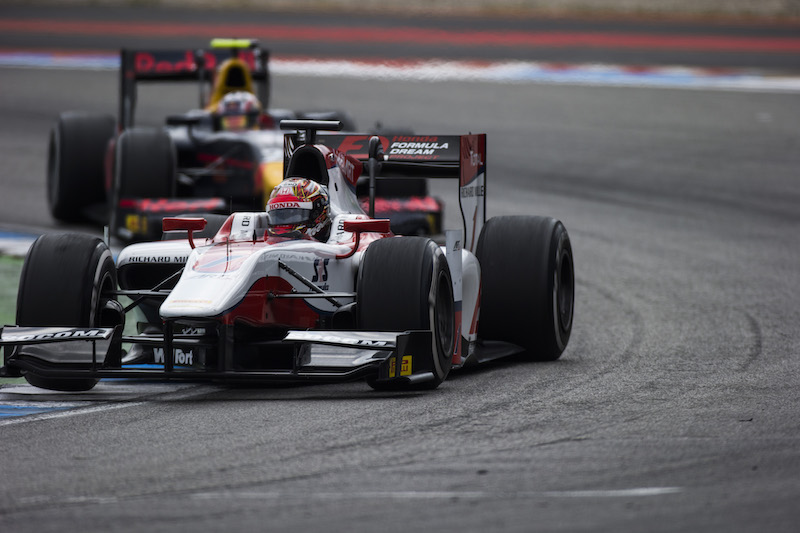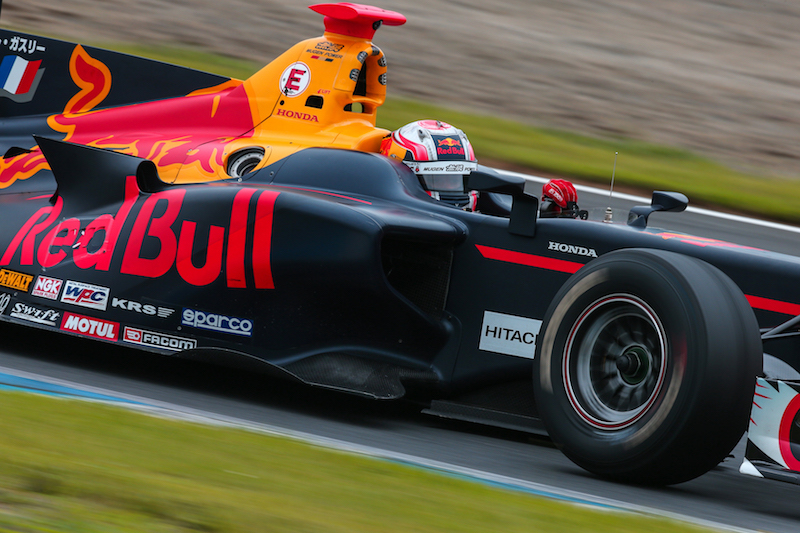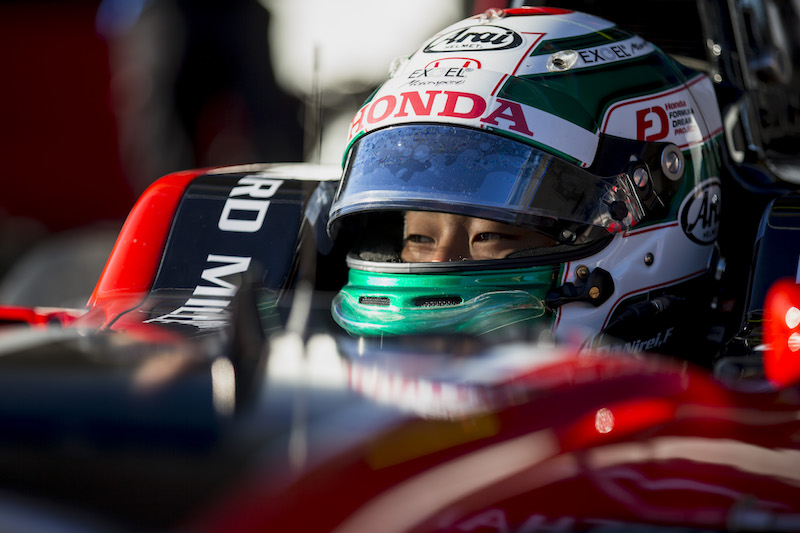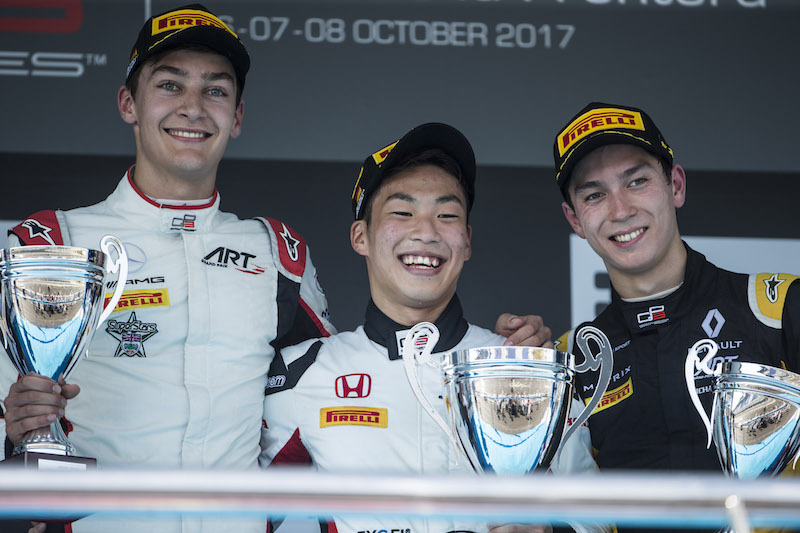
Photo: Sam Bloxham/GP2 Series Media Service
Honda and Toro Rosso seem like strange bedfellows – on one side is currently the least attractive engine package in Formula 1, and on the other is Red Bull’s junior team, the former Minardi team based at Faenza with no previous experience of working with a major manufacturer.
Clearly, there are some motivations for working together from 2018: for Honda it’s a way to continue the F1 project after the separation from McLaren, and to do in a potentially more patient environment, while for Toro Rosso there’s a large new income stream as well as a potential option for parent Red Bull in its search for a future engine partner.
Those might be the main benefits of working together, but there’s another area in which the two parties can help each other going forward: driver development.
Drivers were a topic of public discussion soon after the deal was announced, and much of the chat was around Pierre Gasly. With Carlos Sainz moving to Renault as part of the engine swap between McLaren and Toro Rosso, at least one vacancy was going to open up at Toro Rosso. Expectation was that Gasly would be first in line for it, not only because he had been due such an opportunity since winning last year’s GP2 title, but also because he had been working with Honda in Super Formula this year, and doing a fine job too.
As it turned out, Toro Rosso didn’t even wait for Sainz to depart before it gave Gasly his chance, and this week the new cooperation with Honda was clear to see as the Frenchman headed back to Japan to try and secure the Super Formula title, rather than compete in the United States Grand Prix – although this ended in disappointment when the final races were cancelled due to a typhoon threat.

Photo: GEPA pictures/Dutch Photo Agency
Still, there is room for this to be just the beginning of?a new partnership between Red Bull and Honda on drivers, as shown by the difficulty Red Bull has had in replacing Gasly for Austin.
An unusual lack of F1-ready talent in the Red Bull junior setup led it to choose Brendon Hartley, a driver dropped from that very scheme eight years ago for lacklustre performances against Daniel Ricciardo in Formula Renault 3.5.
There are number of reasons behind the current gap in the Red Bull driver production line, with Helmut Marko’s increasingly high standards in the wake of Max Verstappen’s rise being one of them, but the end result is that there is a lack of young drivers who look likely to be promoted into a Toro Rosso seat in the coming seasons.
This is where the new alliance with Honda can come in.
Helping Japanese drivers into F1 has been a clear objective for Honda since before its hybrid engine supply began in 2015, with Takuya Izawa initially placed in GP2 alongside Stoffel Vandoorne at ART Grand Prix the season beforehand at the age of 29.
Nobuharu Matsushita has occupied that very seat in the three seasons since after claiming the Japanese F3 title, but although he was given an official development driver role at McLaren, the chance for a home-grown racer to compete for the team was always going to be slim.
Therefore Matsushita tested for Sauber at the Hungaroring in the summer with a view to racing for the team in 2018 when it was due to become Honda’s second customer – only for that supply deal to be canned.

Photo: Sauber F1 Team
When the Toro Rosso deal was announced, there was speculation that Matsushita would be placed there instead, even at the expense of any opportunity for Gasly, but his failure to accrue enough superlicence points soon put paid to such talk.
Still, joining forces with Toro Rosso is perfect for Honda in terms of it getting a driver to F1, given Faenza’s long-standing reputation as a team for developing young drivers. Additionally, Honda can benefit from the expertise that the wider Red Bull junior programme has to help its drivers to gain the skills and the results necessary to make that step.
For Red Bull, Honda can immediately provide it with drivers who can fill its shortage in the categories immediately below F1.
Firstly there’s Matsushita, who showed promise when he first arrived in GP2 without any experience of European racing. Since then, his progress has stalled a little, and although he has taken a couple of sprint race wins, his feature race form is not as strong as may be expected in his third season in the category.
Red Bull could be in a position to guide Matsushita and help him to secure the necessary superlicence points next season, but it wouldn’t be a surprise if it looked beyond him and instead focused its attention on Nirei Fukuzumi.
Fukuzumi came to Europe last year after a single race-winning campaign in Japanese F3, and showed promise in his rookie season in GP3, finishing seventh in a strong field.

Photo: Zak Mauger/GP3 Series Media Service
This year he came back for more, staying with ART Grand Prix, and has rivalled team-mates George Russell and Jack Aitken, proteges of Mercedes and Renault respectively.
He took a maiden win in the first race of the season at Barcelona, aided by a breakdown for Aitken, but his most impressive performance to-date came at the stand-alone round in Jerez earlier this month.
That event was set to be a head-to-head between title favourite Russell and his closest rival Aitken, both of whom had been race-winners at Jerez in Formula Renault. Yet Fukuzumi beat both to pole position and the opening victory in his first race at the circuit.
It was a result that must surely elevate him from promising prospect to a genuine talent capable of reaching F1 on merit, rather than just because Honda has pushed him there.
Bad luck has arguably hurt Fukuzumi this season more than it has his rivals, with mechanical issues causing no-score weekends at both Silverstone and Monza, the latter after he had been due to start on pole. When able to, he has performed well, with the on-track incidents of last season much less of an issue this time around.
He currently looks Honda’s best bet for a successful home-grown F1 talent. During its last stint in F1, the company took Takuma Sato to the podium. In the year Sato has capped his career with Indy 500 victory, Fukuzumi is showing the sort of potential that could make him Japan’s most successful F1 racer yet.

Photo: Andrew Ferraro/GP3 Series Media Service
Red Bull would not previously have had any interest in a driver backed by Honda, but?given the new partnership between the two firms, taking Fukuzumi on seems a logical move, because he is showing good enough form to earn such status.
Fukuzumi is not ready for an F1 seat yet, partly because he’s yet to meet the superlicence requirements, but as a driver set to graduate to F2 for 2018, he would perfectly fill the gap in Red Bull’s junior ranks, and could benefit from the full support of an F1 junior programme for the first time in order to develop further. His command of English is improving (having lived with team-mate Alex Albon’s family after arriving in Europe), and he has become a popular character in the GP3 paddock.
Honda could provide Red Bull with further options down the line. Tadasuke Makino came over to European Formula 3 at the start of this year with a big reputation, and although he struggled to live up to that early on, he made some impressive progress over the latter part of the season. Honda has a further conveyor belt of young Japanese drivers back home, emerging from the Suzuka racing school and up through Formula 4 and F3.
For now though, it’s Fukuzumi who is making the strongest case to be Honda’s – and maybe Red Bull’s – next new star.